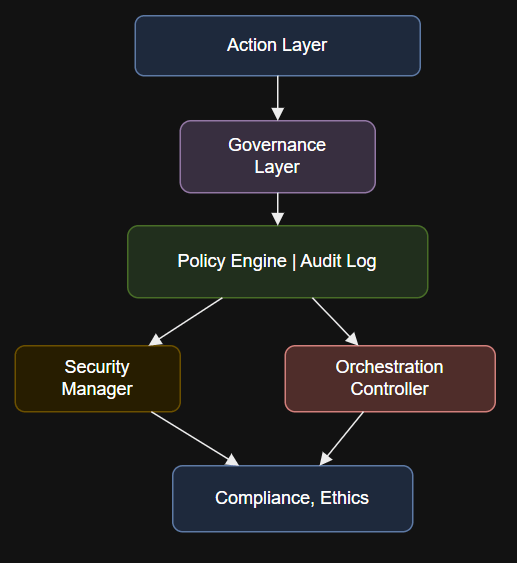Introduction
if __name__ == “__main__”:
# Example: Validate if a user action is allowed by enterprise policy
input_payload = {
“user_role”: “analyst”,
“resource”: “financials”,
“action”: “view”,
“location”: “us-central1”
}
if check_access(input_payload):
print(“Action allowed by policy.”)
else:
print(“Action denied by policy.”)
What This Layer Is and Why It Matters
The Governance Layer is the command center and ethical compass of the agentic AI architecture. This layer provides the oversight, control, and orchestration required to ensure that intelligent agents act in alignment with organizational policies, legal requirements, and ethical expectations. In enterprise settings, the Governance Layer is responsible for everything from access control and audit trails to regulatory compliance and bias mitigation. It also coordinates the behavior of multiple agents or subsystems, enabling reliable, transparent, and accountable AI at scale. Without robust governance, the risks of automation, including regulatory exposure, reputational damage, and systemic failures, increase dramatically.
Diagram

Deep Dive: Components and Data Flow
- Policy Engine: Centralizes enforcement of business, legal, and ethical rules, translating organizational intent into actionable controls.
- Security Manager: Oversees authentication, authorization, and role-based access, integrating with enterprise IAM systems.
- Orchestration Controller: Coordinates and monitors distributed agents or processes, handling escalation, failover, and system-wide optimization.
- Audit Logging and Compliance: Records every action and decision, supports traceability, and generates compliance reports for regulators or internal stakeholders.
- Ethics and Bias Mitigation: Monitors AI behaviors for bias, discrimination, or ethical violations, triggering corrective actions or human review as needed.
Integration Points
Leading tools include Open Policy Agent (OPA) for policy management, HashiCorp Sentinel, Azure Policy, AWS Organizations, and Google Cloud’s Access Transparency. Enterprise use cases cover everything from SOX and GDPR compliance to AI bias auditing, global workflow coordination, and security monitoring.
Production-Ready Script Example (Python, Policy Enforcement with Open Policy Agent)
The Governance Layer is the foundation of trust, safety, and accountability in agentic AI. It delivers the visibility, controls, and orchestration needed to align automation with business values, legal requirements, and ethical standards. For enterprises, investing in a robust Governance Layer ensures that AI deployments are secure, compliant, transparent, and future proof. As intelligent agents become more autonomous, governance will remain the cornerstone of sustainable, risk-managed innovation.
def check_access(input_payload):
response = requests.post(OPA_URL, data=json.dumps({“input”: input_payload}))
result = response.json()
return result.get(“result”, {}).get(“allow”, False)import requests
import jsonThis script integrates live policy evaluation into enterprise applications, ensuring every action adheres to governance mandates.
The Governance Layer functions as both the supervisor and rule-setter for all other layers. It enforces business rules, ethical boundaries, and regulatory mandates, providing guardrails for every AI-driven decision and action. This layer integrates with security frameworks, policy engines, and compliance platforms to manage permissions, monitor operations, and trigger responses to violations or anomalies. In multi-agent environments, the Governance Layer also orchestrates collaboration, handles conflict resolution, and enables global optimization across distributed AI workflows. For enterprises, strong governance ensures operational integrity, regulatory readiness, and sustained trust in AI-powered outcomes.
External Reference
Explore enterprise-grade policy enforcement and governance:
Open Policy Agent Documentation
Conclusion
Below is a real-world Python script for policy validation using Open Policy Agent’s REST API.
Prerequisites: Python 3.9 or newer, OPA running as a local or remote REST service, requests.



